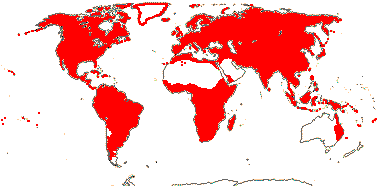Family name: Salicaceae Mirabel
Synonym(s): Bembiciaceae R. C. Keating & Takht.; Caseariaceae Baum.-Bod., nom. nud.; Flacourtiaceae Rich. ex DC., nom. cons.; Homaliaceae R. Br.; Patrisaceae Mart., nom. nud.; Prockiaceae Bertuch; Samydaceae Vent., nom. cons.; Scyphostegiaceae Hutch., nom. cons.
Common name(s): willow family
*Number of genera/species: 53/1,220
List of genera records in GRIN-Global
Fruit dehiscent, loculicidal or septicial capsule (2–6 valved) or indehiscent berry, sometimes drupe (Flacourtia) or samara (Neopringlea), 0.8–100 mm long, globose to angular, terete in transection, style or style remnants often persistent, sometimes beaked, 1- to many-seeded, often subtended or enclosed by persistent perianth. Pericarp brown, black, purple, gray, red, orange, yellow or green, dully or shiny, thin or thick, leathery, bony, woody, sometimes fleshy or succulent (berries), glabrous or pubescent (cottony or silky hairs, to 5 mm long), smooth or grooved (when dry), striate, ridged, ribbed, wrinkled, veined, spiny, bristly, or with resinous dots or spongy emergences.
Seed usually ovoid or angular, terete or compressed in transection, 0.3–6 mm (in winged seeds, to 40 mm including wing). Wingless or if winged, dorsally winged or keeled (Abatia), wing thin, papery or membranous, squarish or rectangular and surrounding seed (Itoa, Poliothyrsis) or extending from one end only (Carrierea). Often arillate, aril white or red, fleshy, lobed, attached to hilum. Seed coat black, brown, reddish or purplish brown, gray, green, yellow, or white, rarely mottled, dull, rarely shiny, glabrous or pubescent, sometimes densely so, smooth or warty, pitted, wrinkled, striate, punctate, reticulate, or resinous glands. In Salix and Populus, seeds with tuft of long hairs at one end or coma, sometimes interpreted as arillate.
Embryo well developed, partially to completely filling seed coat, axile and centric, linear or foliate, straight or C-shaped. Endosperm or perisperm scant.
| Fruit | |
| Type | capsule or berry, sometimes drupe or samara |
| Size range | 0.8–100 mm long |
| Shape(s) | globose, ellipsoid, oblong, fusiform, ovoid, conical, pyriform, trigonous, angular |
| Texture | thin or thick, coriaceous, bony, woody, sometimes fleshy or succulent (berries) |
| Surface relief | smooth, grooved (when dry), striate, ridged, ribbed, wrinkled, veined, spiny, bristly, with resinous dots or spongy emergences |
| Color(s) | brown, black, purple, gray, red, orange, yellow, green |
| Unique features | Usually capsules or berries, with numerous often winged and/or pubescent seeds or seeds with white or red fleshy arils. |
| Seed | |
| Size range | 0.3–6 mm long, or if winged up to 40 mm including wing |
| Shape(s) | usually ovoid or angular, sometimes globose, ellipsoid, oblong, biconical, reniform, cylindrical, or lens-shaped |
| Surface relief | smooth, warty, pitted, wrinkled, striate, punctate, reticulate, with resinous glands |
| Color(s) | black, brown, reddish or purplish brown, gray, green, yellow, or white, rarely mottled |
| Unique features | Small, often winged or pubescent, ovoid or angular seeds. |
| Other | |
| Embryo | well developed, partially to completely filling seed coat, axile and centric, linear or foliate, straight or C-shaped |
| Nutritive tissue | endosperm or perisperm scanty |

Distribution map courtesy of Angiosperm Phylogeny Website.
Bingham et al. 2021+; Chase et al. 2002; Goldberg 1986; Flora of North America Editorial Committee 1993+; Hyde et al. 2021b+; Kirkbride et al. 2006; Masters 1871; Sleumer 1954; Sleumer 1975; Sleumer 1980; Takhtajan 2009; van Heel 1967; Zhengyi et al. 2004+
*The number of genera and species is based on Christenhusz and Byng 2016, which may differ from the number of genera in GRIN-Global.